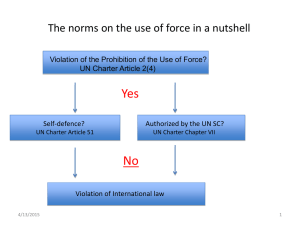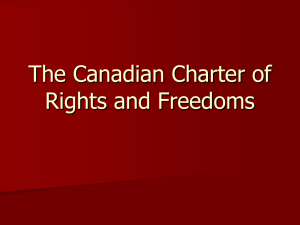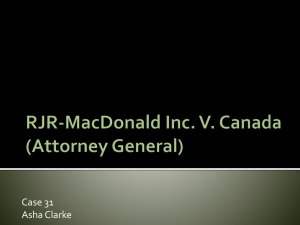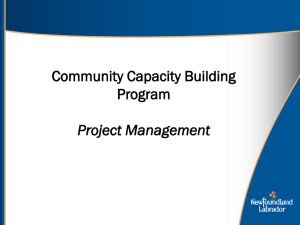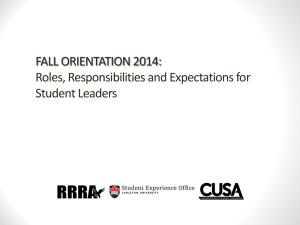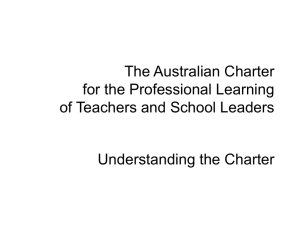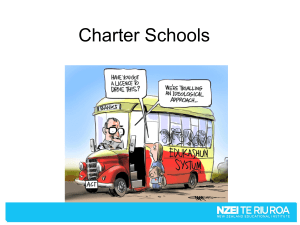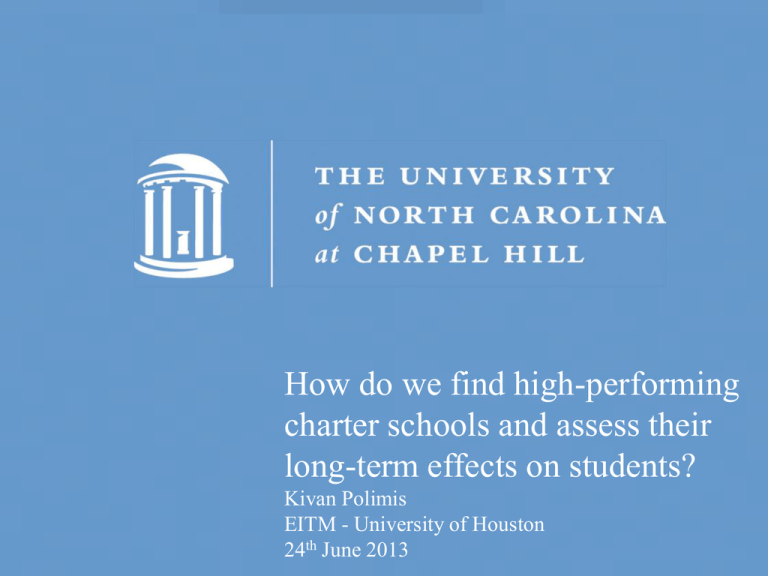
How do we find high-performing
charter schools and assess their
long-term effects on students?
Kivan Polimis
EITM - University of Houston
24th June 2013
Education and Stratification
Educational attainment linked to:
success in the labor force
Pascarella 2005; Day & Newburger 2002
health outcomes
Shuey & Willson 2008; Ross & Wu 1996
marriage prospects
Biblarz & Raftery 1999; DiMaggio & Mohr 1985
Reform in the age of NCLB/R2T
No Child Left Behind (NCLB)
Passed in 2001
Standards-based reform
Focus on assessing student achievement through
quantitative instruments
Race to the Top (R2T)
Passed in 2009
Provides billions in funding for innovative state
solutions to a variety of school reform goals such as
improving teacher quality, developing core standards
and restructuring low-achieving schools
What interventions?
Financing reform
Charter schools
Voucher programs
Contracting
Improving human capital
Leadership institutes for teachers/administrators
Value-added models for teacher quality
Institutional restructuring
Year-around school
Digital learning
Out-of-school you development programs
Growth of Charter Schools
Charter schools are growing in popularity, with the population of
charter school students growing by over 600,000 students from 2009
to 2012 alone (National Charter School Resource Center 2012).
Charter schools serve over 2 million and supply and demand for
this sector remains strong.
41 states and the District of Columbia have charter school legislation
Most of the remaining nine states, (Alabama, Kentucky,
Montana, Nebraska, North Dakota, South Dakota, Vermont,
Washington (state), and West Virginia) have produced legislation
in recent years that has failed to garner enough votes (National
Charter School Resource 2012).
Charter School Proponents
Point to an overly bureaucratic educational system that stifles
teacher innovation and limits their ability to provide high quality
instruction (Chubb and Moe 1990; Murphy and Shiffman 2002).
Believe that charter schools can operate more efficiently than
regular public schools, both financially and instructionally
View the current public education system as a monopoly with no
incentive to change because it faces no threat of competition.
If parents had multiple school options for their children, then it
is thought that public schools will be forced to reform
themselves and their practices and increase student
achievement in order to compete with other options.
Markets and School choice
Parents and students will be able to become active consumers of an
educational product, and as such, they will be able to make school
choices that best fit their needs, educationally and socially.
Given a wider choice in schools in which to enroll their children,
parents will “shop around” (Schneider et al. 1998), and then will
make an informed decision as to which school best fits with their
own educational beliefs and needs.
Initial research questions
School achievement and life course outcomes are closely linked and little
research has explored the longitudinal outcomes for students that attend
charter schools
How do we identify high-performing charter schools?
How do charter schools influence post-secondary outcomes such as college
attendance, labor force participation rates and health outcomes?
Solving problems from sample self-selection
Estimates of school effects are likely to be driven by sample selfselection
Certain socio-demographic groups (esp. advantaged groups)
may favor one schooling environment over another and bias
estimates of that environment’s effect
Who chooses and Why?
Witte and Thorn (1996) have noted, one of the most important sets of
research questions in relation to the issue of public school choice is “Who
chooses and Why?”
This question set is important because as many have noted, there is a
persistent fear, especially among opponents of public school choice that
expanded public school choice may lead to an increase in school segregation
along racial/ethnic and socioeconomic lines (e.g. Henig, 1994, 1998; Kleitz,
Weiher, Tedin, & Matland, 2000; Weiher & Tedin, 2002).
Charter school self-selection
Given self-selection issues, it is important for us to
understand what kinds of students choose to leave their
current schools in favor of enrolling in charter schools so
that researchers and policy makers can make more
informed opinions on the effect of charter schools for
parents, students and the public school districts within
which they are located
Concern with School choice
Bifulco and Ladd (2006) note:
Opponents of expanding school choice are concerned that, in the
absence of provisions carefully designed to counter [re-segregation]
trends, the more motivated and advantaged students will sort into
high-quality schools with students largely like themselves, leaving the
less-advantaged students even more concentrated in lower-quality
educational environments than otherwise be the case. (p. 31)
Rise of re-segregation
Using school level demographic data from the National Center for
Education Statistics (NCES) Common Core of Data (CCD) from the
late 1960s to 2006, Orfield and Lee (2007) note that in 2006
the average white student attends a school that is 77 percent
white majority,
while the average African American student attends a school
that is 52 percent African American and only 30 percent white.
Seventy-three percent of African American students are enrolled in
American schools that are more than 50 percent minority, a level of
segregation approaching that found in 1968 (77 percent).
Further, 38 percent of African American students attend schools that
can be categorized as intensely segregated, those schools that enroll
a greater than 90 percent minority population.
Racial self-sorting in charter schools
Booker, Zimmer, and Buddin (2005) found that charter
schools in both states are having an effect on the racialethnic sorting of students specifically,
“black students in particular tend to move to charter
schools that have a higher percentage of black
students and are more racially concentrated than the
public schools they leave” (p. 22).
Academic quality trumps
(Schneider et al. 1998) examined how parents differed by race-ethnicity and
socioeconomic status (as proxied by educational level) in their evaluation of
the importance of four separate dimensions of schools:
(1) academic quality measured by high test scores:
(2) racial composition;
(3) values;
and (4) discipline.
Found that African American parents and those who had graduated high
school but had not attended college were more likely to indicate that
academic quality was important compared with parents of other racialethnic groups or education levels.
Schneider et al. also found that racial similarity of a school student body to
the parent’s own race-ethnicity was rarely reported as important. In terms
of racial diversity they found that white and college educated parents were
more likely to indicate this factor as more important than minority and less
educated parents.
Assessing parental preferences
Empirical evidence of parental school preferences comes
generally from two different sources.
First, many studies have used surveys of parents to
gauge the importance of various school
characteristics (e.g., academic quality, racial
composition, etc.) on their choices.
Most of these surveys show that all parents, regardless of
race-ethnicity or socioeconomic status, tend to indicate
that academic quality of schools is at the top of their list
of important characteristics (Schneider and Buckley
2002).
Preferences are unclear
Weiher and Tedin (2002:81) clearly state the problem
with many of these studies:
“A common weakness of this research into the ethnic
and racial implications of choice for choosers
themselves is that the linkage between respondents’
stated preferences and actual racial and ethnic
patterns in choice schools tend to be tenuous” (p.
81).
One obvious reason for this is the social undesirability of
expressing racial/ethnic reasons for choosing a school.
Evidence of race-sorting in charter schools
Bifulco and Ladd (2006) also found results of student
sorting based on race-ethnicity:
Using school level data from the CCD for the 20012002 school year, the authors found that students
enrolled in a charter school are “two and a half times
more likely to be enrolled in a racially unbalanced
school” than if they were in a traditional public school
(p. 37).
African American students attended charter schools that
were 18.6 percent more African American and white
students enrolled in charter schools that were 10.7
percent less African American.
Matched pairs analysis
Using data from the National Longitudinal Survey of Adolescent Health (Add
Health), the proposed research will focus on analyzing how student
academic performance is affected by charter school attendance.
Add Health, is a nationally representative, school-based longitudinal study of
the early life course. I will focus on the results from the in-school student
questionnaire, the in-home student interview and the parent interview for
adolescents that were enrolled in grades seven through twelve and
completed the survey’s first wave (Wave I) in 1994-1995 as well as Wave III
and Wave IV. Add Health’s subsequent waves will provide educational
attainment information as well as the foundation for tracking changes in lifecourse trajectories related to health, wealth and marriage.
The core of the analysis will focus on examining the differences in
trajectories for students that attended a different charter high or
comprehensive high school but similar middle schools..
More matched pairs
Use students from the same middle school in national
data to approximate effect of charter school attendance
Cook, Shadish and Wong (2008) demonstrate the
importance of matching treatment groups with intact
control groups that maximize overlap between the
treatment group and control group on pre-test measures
Gains score equation
Ajt −Ajt−1 = αCjt + µj + δgt + υjt
Where Ajt − Ajt−1 is a measure of the (math or reading) achievement
gain of the jth student in the tth year; Cjt is an indicator whether
student j attended a charter school in the tth year; µj captures the
individual student fixed effect; δgt captures the grade-by-year fixed
effect; and υjt is the random disturbance term.
This approach minimizes selection bias only to the degree the
observable characteristics used for the matching controls for sorting of
students across charter and traditional public schools.
HLM models
The primary analyses for evaluating an intervention program
employ hierarchical linear modeling (HLM) within a multi-level
growth curve framework (Raudenbush and Bryk 2002; Wong
and Mason 1985; Singer and Willett 2003).
Specifically, the models nest various achievement trajectories
within children, who are nested within schools. The Level-1
HLM models estimate children’s individual achievement
trajectories within a school. At Level 2, these achievement
trajectories are nested within schools. HLM models control for:
prior performance but also for each student’s ethnicity,
nativity, sex, grade level, and socioeconomic status..
Contributions
Charter school studies traditionally analyze proximate effects on student
achievement such as test scores in secondary school and few studies
examine charter school effects on long-term results in high school such as
graduation and retention rates (Berends et al. 2006; Hill, Angel and
Christensen 2006).
This study represents an initial attempt to understanding the influence of
charter school attendance beyond secondary school and into postsecondary outcomes such as college attendance, labor force participation
rates, and health outcomes which are almost entirely ignored within charter
school literature.
Research Questions
1. What are the demographic and academic achievement characteristics of
students who choose to switch to a charter public school ?
2. What are the most important reasons that parents report when choosing
a charter school for their child? Do these reasons differ among racial-ethnic
and socioeconomic groups of parents?
3. How do these professed reasons for choice compare to actual choice
behavior?
4. What are the effects of charter school choice on the sorting of students
along racial-ethnic and achievement level dimensions?
Previous studies
On average, one third of students, across racial-ethnic groups and previous
school type, choose to enroll in a charter that had passed AYP. Most
interesting is the finding that 32.5 percent of parents and students are
choosing to enroll in charter schools that are new and therefore have no AYP
designation.
Parents may base their determination of school quality on indicators other
than AYP such as personal contact with school personnel
(Stein 2006)
Previous studies (continued)
Overwhelmingly parents indicate that school quality was
the main driver of their choice of a charter public school
in which to enroll their children.
However, this reason for choice is less clear when
parents’ actual choices are examined in terms of the AYP
status, a highly visible and public indicator of ‘quality,’ of
the schools they choose verses the schools they are
leaving.
Hypotheses
• There may be some general patterns to these choices
based on a student’s own race/ethnicity, the racial
composition of charter schools relative to previous
schools, and academic achievement
EITM and school choice
EITM Step 1:
Intuition: Families participate in school choice programs that maximize
their utility
Theoretical concept: Decision theory
Statistical concept: Nominal choice
Design a model that estimates what families will participate in a school
choice program based on different program features as well as
characteristics of families and students.
EITM and school choice
EITM Step 2:
Behavioral analogue: Utility maximization
Statistical analogue: Discrete choice modeling
Use discrete choice models to calculate changes in family participation
from changes in the attributes of a school choice program (mission,
religious affiliation, etc.)
EITM and school choice
EITM Step 3:
Based on the assumptions and the previous steps, offer a theory about how
families behave in particular situations – particularly, how they behave
under different choice sets produced by school choice programs.
I would test my hypotheses by comparing the school enrollment
populations for cities with different school choice programs. Along these
lines, I will evaluate student populations for cities with school choice
programs that only include public school options side-by-side with student
populations for cities incorporating public and private school options in a
school choice program.
Given environmental controls for the socio-demographic and socioeconomic composition of cities, I would attempt to understand how
changes in choice structure affect the types of families that participate in a
reform.
Contributions
Highlights the need for us to better understand the
motivations and reasons behind self-selection into
(potentially) segregated school environments that may
operate not only within school choice but within
traditional public schools as well due to neighborhood
schools and residential segregation
Questions?
kpolimis@live.unc.edu
Thanks for your time!
Section divider here


